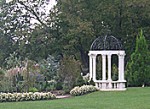 Sunny skies, high temperatures without humidity, and less rain have made gardening this week a pleasure. The soil has dried considerably and the fungi that have plagued the lawn are at bay; the blackspot too. As the school children start their new year I can’t help but start the planning process for next year’s garden starting with the bulb order and the transplanting iris.
Sunny skies, high temperatures without humidity, and less rain have made gardening this week a pleasure. The soil has dried considerably and the fungi that have plagued the lawn are at bay; the blackspot too. As the school children start their new year I can’t help but start the planning process for next year’s garden starting with the bulb order and the transplanting iris.
My iris bed started with a couple of transplants from my Maryland garden but has grown considerably with gifts, purchases and divisions. Now the iris take up a very large space around the fish pond and they need come company to provide color after they have faded. Daylilies are the plant of choice for this role and so moving out some iris is the first step. I have cut back all those I am about to dig up and give away.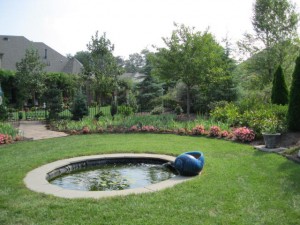
In the formal garden the huge clump of zebra grass has a friend, Mexican sunflower, Tithonia rotundifolia.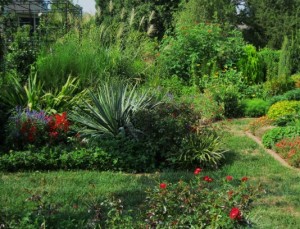
This annual grows into a monster plant. I started it from seed in the spring and here it is finally blooming. There is a shorter cultivar that takes longer to bloom but the large size fits in well with the zebra grass.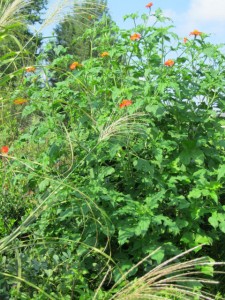
Considering how much green it produces and how little the flowers I sometimes wonder if I should bother with it. But then it blooms and those bright vivid orange flowers win my heart and admiration.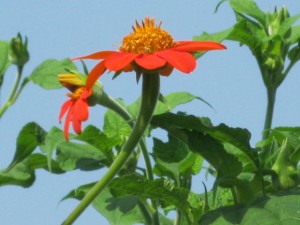
Sedum ‘Autumn Joy’ is showing a bit of pink and creates a subtle echo with the New England aster “Alma Potschke’ next to it.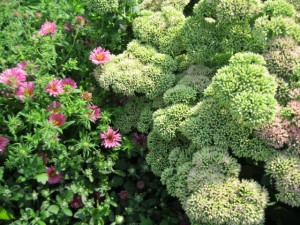
The rose ‘The Fairy’ is a pale pink like the sedum and forms a pleasant combination with Russian sage in the background and artemesia and lamb’s ear.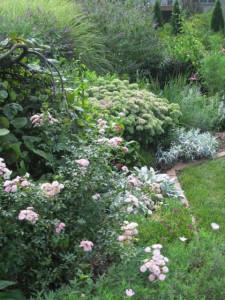
The Russian sage also pairs nicely with the lythrum and phlox. Lythrum is highly invasive in some areas but I have had it for many years and it has very slowly formed a larger clump but never strayed. The supplier from whom I bought it said it was sterile and perhaps it is. Lythrum can be a great garden plant and it is a great pity that it has invasive tendencies when conditions are right.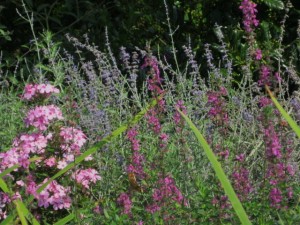
The red barberry adds color all summer into fall and provides a good companion for celosia, fescue, portulaca, balloon flower and the asters that are about the bloom.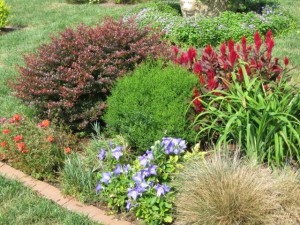
I bought these asters at the local farmers’ market a couple of years ago and they have done very well with no sign of mildew. The look good all season, forming a fine texture mound until they flower.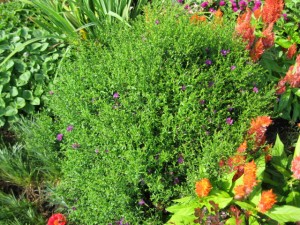
The flowers open slowly which is part of their charm. They can be lavender blue…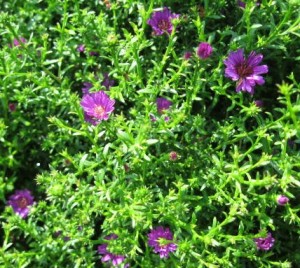
or pink. Eventually the whole mound will be covered with these tiny flowers.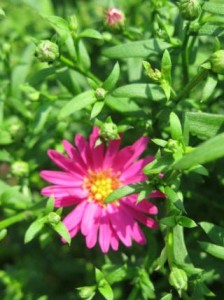
A speaking of small daisy like flowers, the boltonia on both sides of the bench are putting on quite a display.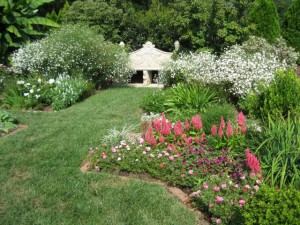
The climbing rose ‘Olive’ is putting on a display.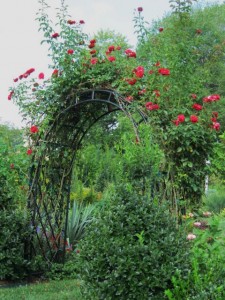
It bears large fragrant flowers in clusters.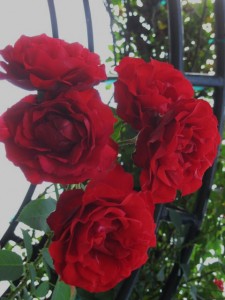
Nearby a red patio rose grows with celosia and vinca, verbena ‘Homestead Purple’ and a mass of variegated lirope.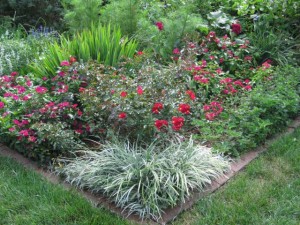
In the rose garden ‘Mrs. B. R. Cant’ is blooming. It is a very large bush!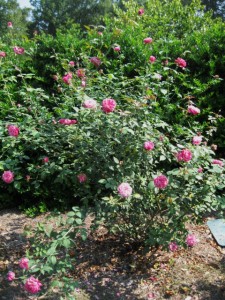
She is a tea rose, not to be confused with hybrid tea, struggles through our winters but thoroughly enjoys the heat of our summers. Her flowers are usually quartered and have a gentle tea-like fragrance.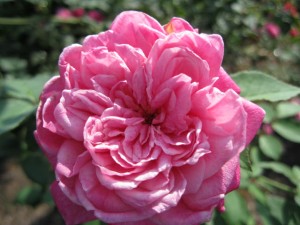
The moonvine in the rose garden is really getting into stride. It has grown up the trellis and now is moving over the top.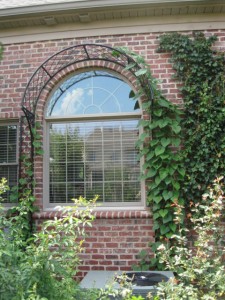
The flowers are coming on a regular basis. Fabulous!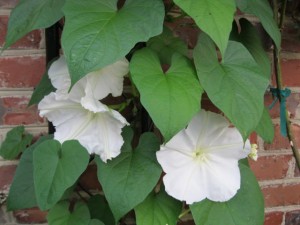
The cardinal vines in the pots in the boxwood parterres are getting bushy and producing a lot of flowers. The pots contained mum plants from last year when I planted the vines and put the trellis’ in place. The vines obligingly bushed out at the top rather than at the bottom leaving the mum plants in the sun.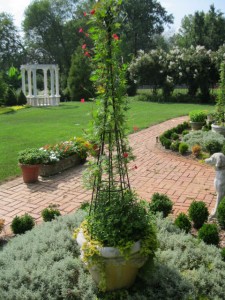
The humming birds love the red flowers and visit frequently.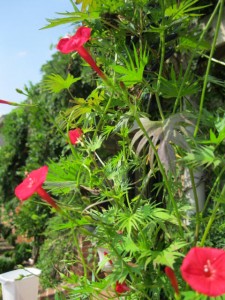
A new purchase this week was this very handsome pitcher plant. We found it at the local farmers’ market and had to remove some iris from the bog garden in order to make room for it. This vendor has many different kinds of pitcher plants and I suspect we will get some more.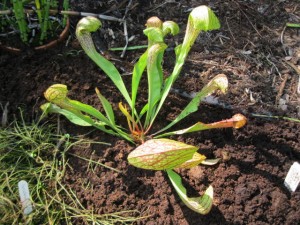
Two dwarf crape myrtles and deodora cedars make a backdrop for our new acquisition.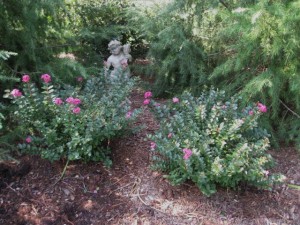
The cutting garden provided a bouquet of zinnias. Notice the clay pot. I found it at a roadside stand in Maryland; very cheap, crude, fragile, and loveable. I put a cut down orange juice container in it to hold water and use it every year for zinnias.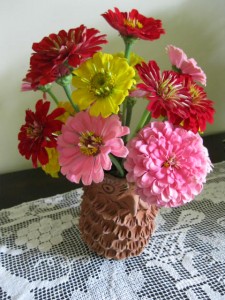
I over fertilized the eggplant plants this year and have big bush plants with little fruit. Several bushes, however, are covered with flowers now and I am hopeful that I will have an avalanche of eggplants soon.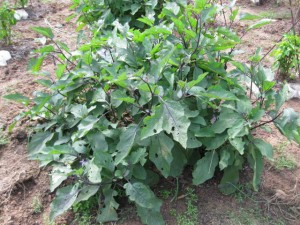
The new plantings of lettuce, radishes, and beets went in along side the row of basil and are already up. (The white stuff is sand that we use to cover the seeds.)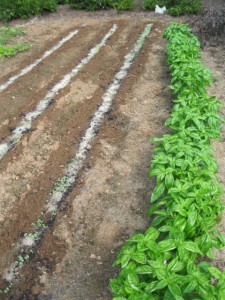
It is hard to believe that the cool weather crops are in the near future. Now if we could get these 90+ degree days over with I could really settle down into my autumn mode.
